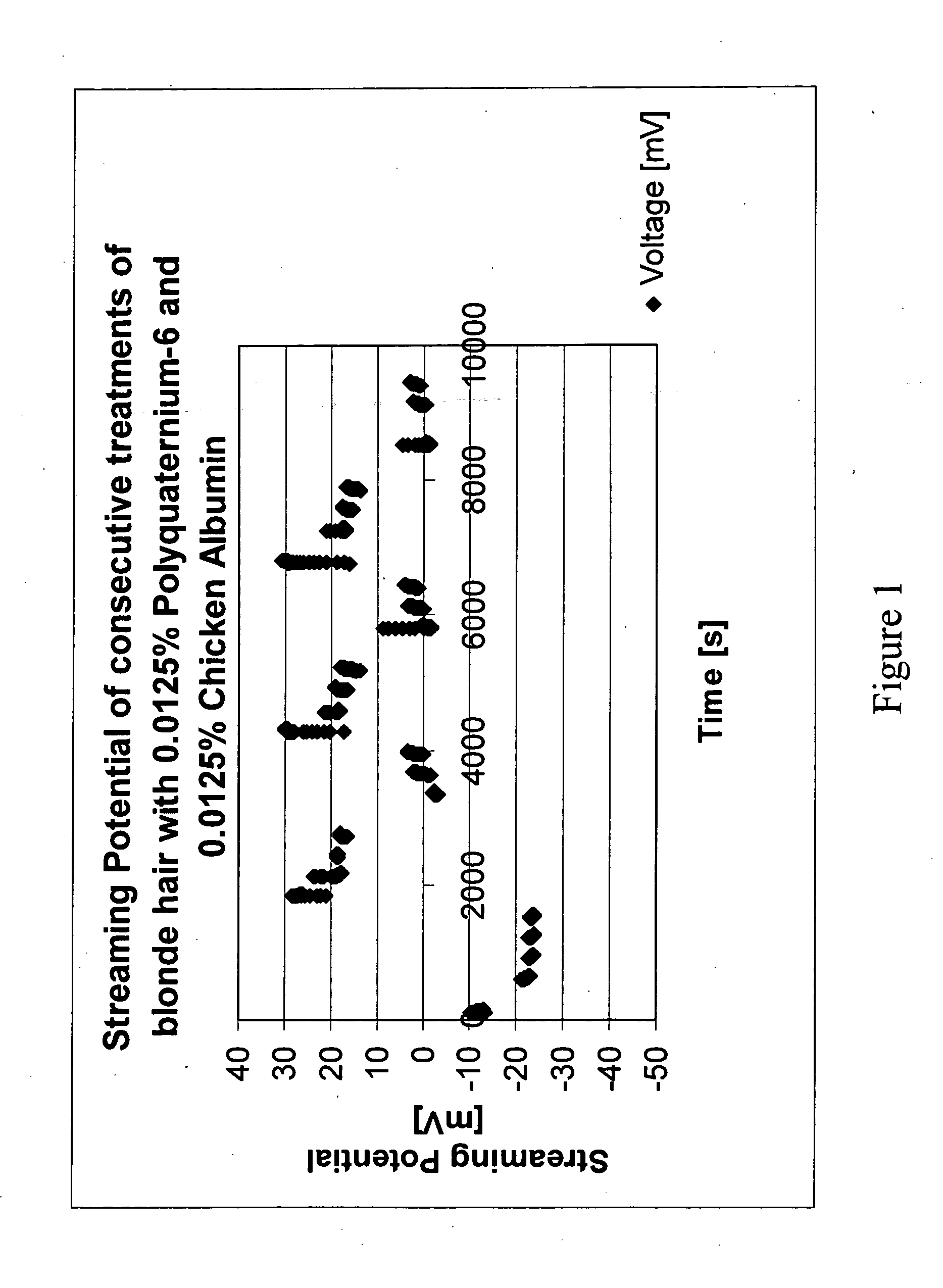Methods and kits imparting benefits to keratin-containing substrates
a technology of keratin and substrate, applied in the field of methods of imparting benefits, can solve the problems of reducing the reducing the look, feel and ease of combing of hair, and inacceptable hair attributes
- Summary
- Abstract
- Description
- Claims
- Application Information
AI Technical Summary
Benefits of technology
Problems solved by technology
Method used
Image
Examples
example 1
[0060]Streaming potential analysis was conducted on blonde hair showing the effect on streaming potential of a first treatment with a solution of cationic polyquaternium-6 (available as Merquat 100 from Nalco Company in Naperville, Ill.) and a second treatment with a solution of anionic protein chicken albumin (available from Sigma Aldrich, St. Louis, Mo.). The solutions of 0.0125% cationic polyquaternium-6 and 0.0125% anionic protein chicken albumin were prepared and utilized at the concentrations noted above in 1 mM KCl in deionized water.
[0061]Referring now to FIG. 1, the first five data points_correspond to untreated hair, the next four data points correspond to hair after treatment with the cationic polyquaternium-6, and the next three data points correspond to hair after treatment with the anionic chicken albumin. The cycle of treatments was continued two more times. The increase in surface charge after the cationic polyquaternium-6 treatment shows that the polyquaternium-6 is...
example 2
[0062]Combing analysis of blonde hair treated by consecutive multilayer deposition of this invention was conducted. All solutions used for the treatments consisted of 1% of the active composition in deionized water.
[0063]Combing analysis was conducted on the untreated hair, on the hair after a first treatment with 1% polylysine, on the hair after a second treatment with 1% albumin, and finally on the hair after a third treatment with 1% SLES. Table 2 shows the results of the combing analysis.
TABLE 2Combing forceTreatmentSource of Active(Joules)Std. dev.UntreatedN / A2.51E−010.0289211% polylysineSigma Aldrich (P6516)1.85E−010.0207891% chicken albuminSigma Aldrich1.36E−010.0204351% SLESRhodia, Cranbury, NJ1.20E−010.060033(Rhodapex ES-2K)
[0064]Referring now to Table 2, it can be seen that the work required to comb the hair decreased after the treatment with the polylysine. Surprisingly, the combing force was reduced even further after treatment with albumin and after exposure to SLES, wh...
example 3
[0065]Combing analysis was conducted on blonde hair in a manner similar to that of Example 2 above, except that 1% polyquaternium-6, 1% albumin, and 1% SLES were used as the treatment compositions. The results are shown in Table 3.
TABLE 3Combing forceTreatmentSource of Active(Joules)Std. dev.UntreatedN / A1.47E−010.0043131%Nalco Company1.31E−010.009899polyquaternium-6(Merquat 100)1% chicken albuminSigma Aldrich1.09E−010.0549561% SLESRhodia (Rhodapex ES-9.89E−020.0102322K)
[0066]Referring now to Table 3, it can be seen that the work required to comb the hair decreased after the first treatment with the 1% polyquaternium-6, then decreased further after the second treatment with the anionic albumin, and finally decreased even more after the treatment with the SLES. Again surprisingly, the combing force was reduced even further after treatment with albumin and after exposure to SLES, which can form complexes with the underlying layers. The treatment with SLES did not decrease the ease of c...
PUM
| Property | Measurement | Unit |
|---|---|---|
| Fraction | aaaaa | aaaaa |
| Fraction | aaaaa | aaaaa |
| Fraction | aaaaa | aaaaa |
Abstract
Description
Claims
Application Information
 Login to View More
Login to View More - R&D
- Intellectual Property
- Life Sciences
- Materials
- Tech Scout
- Unparalleled Data Quality
- Higher Quality Content
- 60% Fewer Hallucinations
Browse by: Latest US Patents, China's latest patents, Technical Efficacy Thesaurus, Application Domain, Technology Topic, Popular Technical Reports.
© 2025 PatSnap. All rights reserved.Legal|Privacy policy|Modern Slavery Act Transparency Statement|Sitemap|About US| Contact US: help@patsnap.com

